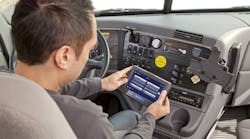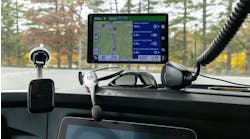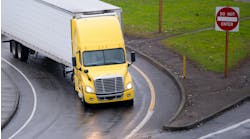Even before the ELD mandate came down the pike, Lindenmeyr Munroe, an independent paper and packaging distributor in the U.S., was constantly on the hunt for ways to improve its fleet operations and to track driving behaviors for better fuel efficiency.
According to Matthew Mascia, corporate transportation and logistics director at Lindenmyr Munroe, when the company began digging into the operations across its 18 facilities, management found that fuel tax reporting and driver shift sheets were the biggest challenges to manage. And that deeper dive into the company’s operations also shed light on unintentional undocumented violations for driver records of duty.
“When the mandate came around, it kind of created the perfect storm for us to really sit down and talk about what we were going to do for our operating fleet,” Mascia explained during a recent Fleet Owner webinar. The webinar, sponsored by Omnitracs, focused on ELDs and the short-haul exemption.
The company has 160 trucks operating on the road today – some of which fall completely into the short-haul exemption, while others do not.
During the same webinar, Joe DeLorenzo, director of the Office of Compliance and Enforcement at the Federal Motor Carrier Safety Administration (FMCSA), explained carriers that fall under the short-haul exemption operate within a 100-air-mile radius (air miles refer to nautical miles, so 100 air miles translates to about 115 road miles).
“Essentially what we do with this short-haul exemption is we say if you’re leaving from the same place and you return to your normal work reporting locations, operating within that 100-air-mile radius, you’re not going to have to fill out a log book,” DeLorenzo emphasized.
Additional qualifications to meet that exemption state drivers can’t exceed 12 hours a day and they can’t exceed the normal 11 hours of driving in that 12-hour day. Under those guidelines, it also means that there’s not necessarily any requirement for any documentation to be onboard the vehicle.
A similar exemption, the 150-air-mile- radius rule, is basically the same as the 100-air-mile exemption except that it won’t apply to most traditional trucking companies as only non-CDL drivers are eligible.
“My advice to anybody that operates under these exemptions is to make sure that your drivers understand the exemption and are able to articulate that in the event that they’re stopped so that it’s clear why they don’t have a log book,” DeLorenzo explained. “It’s also important that at the carrier’s place of business, that documentation of that driver’s time is maintained.”
Additional exemptions to the ELD rule
DeLorenzo also noted there are two agricultural exemptions for the ELD mandate:
- Agricultural (or ag) exemption – Companies transporting agricultural commodity within 150 air miles, not only do not have to fill out a record of duty status, but those hours don’t count toward their daily and weekly limit. For-hire carriers or anyone transporting livestock can take advantage of this exemption.
- Covered farm vehicles exemption – This is more of an exemption for the farmer or family members of the farm. It works very similar to the ag exemption; the key, according to FMCSA, is that if it’s a farm vehicle registered in the state and it’s not a for-hire operation, it’s eligible for this exemption.
“My practical rule of thumb on this particular issue is if you’re not required to fill out a log book today, then you don’t need to have an ELD,” DeLorenzo said. “It really is as simple as that.”
In addition, vehicles manufactured before 2000 are exempt from the ELD mandate. To clarify, pre-2000 refers to the engine model year, not the vehicle model year. So, if a 2000 model year vehicle has a 1999 engine, there is no need to comply with the ELD rule.
“When we wrote the ELD rule, we realized that when you’re trying to make a connection with the onboarding computer, there is a big difference when you’re trying to look at the age of the vehicle,” DeLorenzo noted. “Particularly what we looked at was the cost and the technical needs for connecting to an onboard computer for pre-2000 vehicles just did not make it worthwhile for the rule.”
The second question that comes up regarding the pre-2000 exemption is: What about if a carrier or owner operator adds a glider kit and maintains a pre-2000 engine?
“Just because you change the chassis and the body, the engine is what really matters in this case,” DeLorenzo explained. “So you need to focus on engine model year that is pre-2000 that an ELD is not required. I do like to point out that if you do an engine swap or put on a glider kit, there is a separate regulation that requires documentation that you’ve maintained at your place of business.”
According to DeLorenzo, the most common exemption is going to be the eight in 30 rule, which looks at a rolling 30-day period like the rolling eight-day period drivers keep on their logs. Companies and drivers that are not required to fill out a record of duty status more than eight days during any rolling 30-day period will not have to have an ELD.
In addition, a company that generally operates under the 100-air-mile radius exemption but on occasion exceeds that, could operate under this exemption.
“That’s fine as long as that doesn’t happen more than 8 days out of every 30 you can maintain your hours of service on a paper log,” DeLorenzo added. “You want to make sure drivers could articulate that. What you don’t want to do with these exemptions is figure out on day eight or day nine of those 30 days that you needed to have a record of duty status and therefore have an ELD. It goes by driver, so as a company, if you’re going to manage to this exemption you need to make sure each driver stays within those eight days out of every 30, then you’ll be OK.”
Fleet uniformity and compliance
Perman Rejepov, distribution metrics specialist at Preferred Meals, explained during the webinar that his company’s fleet comprises a mixture of CDL, non-CDL, and long-haul and short-haul operations. Although the entire fleet is not bound by the upcoming rule, Rejepov said the company felt ELDs made sense across its entire operations.
He urged fleets to be vigilant when adopting new devices since many companies say they are ELD compliant when they are not. Rejepov added that before companies begin investing money in ELDs, they should understand the differences between short-haul versus long-haul and the criteria for both.
“Most of our short hauls do not qualify as a short haul based on the criteria for the ELD mandate,” he explained. “We have a route structure that is continually changing.”
According to Rejepov, Preferred Meals found the ELD mandate makes sense for short-haul fleets in general, with potential benefits that include:
- Compliance when tracking air miles and hours of service
- Automated IFTA tax reporting calculation
- Reduced liabilities
- Paperless recordkeeping and reporting
- Unassigned vehicle activity traceability
Some of the challenges the company found along the way include driver resistance when learning how to use the devices, and educating drivers on the meaning of hours of service and the differences between short-haul and long-haul operations. In addition, Rejepov said the company found it challenging to teach its managers how to properly operate under the hours of service regulations for short-haul carriers.
Similarly, Lindenmeyr Munroe implemented ELDs across its entire fleet, in an effort not to handicap itself and to ensure its operations were compliant, Mascia noted.
“Being a sales driven organization, we’re going to make our deliveries where our customers need us to,” Mascia explained. “So if we didn’t have that ability or an unavailable driver, that would be unacceptable from a delivery perspective.”
“For us, preparation has been key, but we are really in the infancy stages as of adoption right now,” he added. “The preparation side of things for us really began when we made the decision. Our partnership with Omnnitracs really went through looking for the right mobile device. For us mobile became the right solution – we were already kind of used to it and really it makes it a lot easier for us when we’re managing subunits and rentals.”
Mascia also noted that over time, the company hopes the devices will help “save nickels” and put some financial benefits back into its bottom line.




